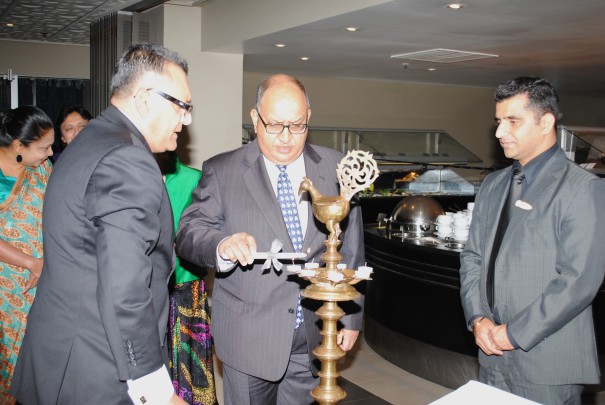Sri Lankan Food Festival

To view images from the event, click here
I begin by greeting everyone in the languages of the realm of New Zealand, in English, Māori, Cook Island Māori, Niuean, Tokelauan and New Zealand Sign Language. Greetings, Kia Ora, Kia Orana, Fakalofa Lahi Atu, Taloha Ni and as it is the evening (Sign). In the context of this gathering I add the greetings, aayubowan, vanakkam and salaam alaikkum.
I then specifically greet you: Aruna Abeygoonesekera, Honorary Consul for Sri Lanka to New Zealand and your wife Hiranthi; Shahane De Costa, President of the New Zealand Sri Lanka Friendship Society and your wife Chrysanthi; Ian McKinnon, Deputy Mayor of Wellington and your wife Jenny; Ambassadors and High Commissioners to New Zealand present; Distinguished Guests otherwise; Ladies and Gentlemen.
It has been a great pleasure for Susan and I to accept the invitation to attend the official opening of the Sri Lankan Food Festival.
I have been asked to officially open the Festival which, I am told, is being held in Wellington for the first time. Just before doing that, I would like to speak a little about Sri Lanka and its many connections with New Zealand.
Those linkages are most obvious in sport, especially cricket. As many will know, the Black Caps faced Sri Lanka in the semi-finals of the last two ICC World Cups with New Zealand being defeated on both occasions.
Some of you will also know of the plaques cemented into the path around the Capital's Basin Reserve. The identical plaques celebrate, in great detail, the many records that were set in a test match between New Zealand and Sir Lanka in February 1991, including New Zealand's highest test score (671-4), the highest score by a New Zealander (299 to Martin Crowe), the highest score at the Basin Reserve, and the world record for any wicket, in a partnership between Martin Crowe and Andrew Jones of 467 runs (in 548 minutes). Aravinda de Silva's 267 was also the highest score by a Sri Lankan. After all that glorious detail of achievement the game ended and is recorded in the last plaque saying: "Match Drawn." Only in cricket could such an outcome be celebrated!
Another linkage is the Commonwealth connection which New Zealand and Sri Lanka share. Both countries having inherited the Westminster tradition which has shaped governance systems in both countries, ensuring that elections are held regularly, with New Zealand it seems holding elections twice as often! Other institutions which demonstrate our two country’s similar approaches to governance are an independent judiciary and an office of ombudsman.
The migration of Sri Lankan people to New Zealand is, likewise, worth noting. That migration began as early as the late 1800s, when Sri Lanka was, of course, known as Ceylon. I understand that in 1874 the number of New Zealand residents born in Ceylon numbered a mere 33!
That number of migrants slowly increased over time with, after 1950, students and trainees coming to receive education in New Zealand under the Colombo Plan. Additionally, a demand for skilled professionals in New Zealand led to a noticeable increase in the 1960s.
Since that time, and particularly in the 1980s, a number of Sri Lankans came to New Zealand as refugees. New Zealand represents an opportunity for a fresh start and I am told that at the 2006 census there were more than 7,000 people of Sri Lankan origin living in New Zealand.
The valuable contribution of people of Sri Lankan descent to New Zealand society is visible notably in the health profession, in business and property services, and the retail and manufacturing sectors. I am reminded of two people, first, the late Dr Upali Manukulasuriya or Dr Manu as he was known to his Taumarunui patients who did much for the Sri Lankan communities as a founding member of the United Sri Lanka Association as well as promoting issues related to general practitioners working in rural areas. Secondly, Dr Nagalingam Rasalingam, a suburban Auckland general practitioner whose advocacy for migrants and refugees is legion.
Sri Lanka is, of course, famously known internationally for its export of tea. While many Kiwis have in modern times become keen coffee drinkers, we have traditionally been a nation of serious tea-drinkers and have enjoyed the import of, what used to be called, Ceylon tea for decades. I will confess at this point that the well known Sri Lankan tea producer, Merrill Fernando, is someone I can call a friend, as a result of the trips he has made to New Zealand promoting in tandem the benefits of tea drinking, notably Dilmah, and cricket.
The last point to make is that the preservation of Sri Lankan culture and tradition here is an important part of the community’s strength. That strength is to be observed this evening, with the wide variety of Sri Lankan cuisine spread before us. I understand that no dedicated Sri Lankan restaurants exist in New Zealand so tonight will represent a very special opportunity to sample that cuisine.
For all these reasons encompassing linkage and enjoyment and as Governor-General of New Zealand, it gives me great pleasure to declare the Sri Lankan Food Festival officially open.
And on that note I will close in New Zealand’s first language offering everyone greetings and wishing everyone good health and fortitude in your endeavours. No reira, tēnā koutou, tēnā koutou, kia ora, kia kaha, tēnā koutou katoa.
